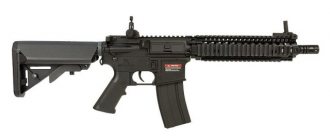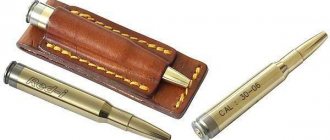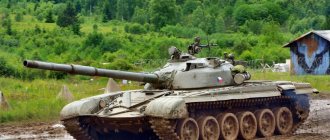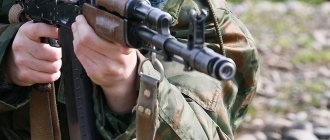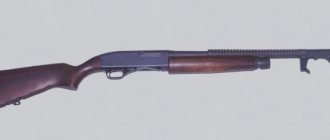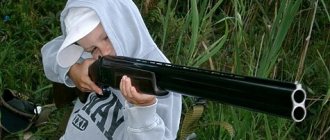A new version of the legendary Kalashnikov assault rifle, the AK-12, has entered the final stage of its production. Last year, batches of these assault rifles already entered service with units of the Central Military District. In October 2022, the press service of the Southern Military District announced that the new product would be available to motorized rifle formations stationed in the Volgograd region. It is reported that the first batch of machines will arrive before the end of the year.
Before getting into the hands of soldiers, the AK-12 went through a long development and testing process. The very history of the production of this assault rifle shows how complex the process of creating a new Kalashnikov assault rifle is. The designers were faced with the task of producing not just another machine gun, but of bringing the AK to a new modern level. The standard with which the new product will inevitably be compared is the AK74M, which is currently the main assault rifle in the arsenal of the Russian army.
Instead of the Dovetail - Picatinny rail
When creating the AK-12, the designers of the Kalashnikov concern were faced with the task of creating an assault rifle that meets modern requirements for small arms. Taking the design of the AK74M assault rifle as a basis, the creators solved the problem of installing various sighting devices and other modules. The obsolete Dovetail rail was replaced with a Picatinny rail mounted on the receiver.
© kalashnikov.media Batches of AK-12 assault rifles have already entered service with formations of the Central Military District and Southern Military District.
On the AK74M, the Dovetail has long been used to install an adapter with a Picatinny rail, on which a sight was already installed. This design was far from the most convenient: the additional bracket made the machine heavier, and the bar itself was subject to vibration when firing, which negatively affected the accuracy and balance of the weapon. Various companies even began to produce additional parts, such as a receiver with a Picatinny rail mounted on top. However, not all manufacturers could maintain the level of quality corresponding to the Kalashnikov assault rifle. As a result, the shooter was faced with a difficult choice: to weigh down the machine gun with a side bracket or to use third-party parts to install the sight. The design of the AK-12 solved this problem - the “native” Picatinny rail was developed taking into account the design features of the machine gun.
By the way
When firing, the receiver of a Kalashnikov assault rifle is subject to vibrations, and the rigidity of the AK-12’s upper rail allows it to absorb vibrations that could impair aiming and, in the future, render the sighting device unusable.
Another important advantage of the new machine, which the concern’s designers are proud of, is the strengthening of the main components of the machine. The AK-12 barrel, which uses new technology, can withstand a burst of more than 600 rounds before it fails from overheating. This figure significantly exceeds the requirements of the Ministry of Defense: an assault rifle intended for use in the Russian army must remain functional after a burst of 180 shots.
Among other advantages of the machine, experts note the new diopter sight and improved ergonomics of the machine. Thanks to many small, targeted changes, the AK-12 has become more comfortable to shoot. Nevertheless, the machine is still similar to its predecessor. The similarity of the AK-12 and AK-74 in ergonomics and design is also an advantage, although not so obvious. When equipping a large army with new weapons, it is important to take into account the fact that unfamiliar elements of the machine gun can cause additional difficulties during operation. Which turned out to be fatal for the previous version of the AK-12.
© kalashnikov.media
The Picatinny rail for mounting a variety of sighting devices and other modules was developed taking into account the design features of the machine gun.
AK-103, AK-203: On the differences in modern domestic small arms
I’m explaining this to you because you clearly don’t understand the effect of barrel and receiver rigidity on ACCURACY. You know, diplomas are for sale. In underground passages and in the subway. Especially in post-Soviet Russia, Ukraine, etc., etc. You know how in the joke “Well, where did you steal your driving license?” “Uh, the boss of the garage, why did he steal it? What if I stole Georgians right away? I didn’t steal my license, I honestly bought it in an underground passage.” This is how many people get their diplomas. Then they clearly don’t understand that if two barrels are both 16.3″ inches long (on an AK74). But one barrel has a diameter of .59 inches, and the second barrel has a diameter of .75 inches. Then, WITH ALL OTHER THINGS EQUAL (that is, the same steel, and the same coating of the barrel bore), barrel number two will have greater RIGIDITY, and if so, ACCURACY. And I’ll explain to the “architects” that the barrel does not fire by itself, it is attached in one way or another to the RECEIVER. And the less RIGIDITY of the receiver, the less ACCURACY the weapon will have. For example. Saiga M has a 1.5mm thick receiver. On the VEPR, in addition to the thickness of the receiver, there are special “reinforcements” (I honestly don’t know what to call them in Russian), on the sides of the receiver, like on an RPK, which make the Vepr’s receiver more rigid and less susceptible to vibrations and “wobbling” when firing ( see the video to which I gave a link). To be fair, any weapon, including the M16, “wobbles” when fired (see slow motion). HOW MUCH it “wiggles” (twists and warps in English) is another matter. Saiga M, and especially Vepr, are NOT inferior in accuracy to the average AR15. (not the cheapest). But the price for this is more weight than an AR15 with an equivalent barrel length (for civilian AR15s this is either 16 inches - on an AK74/saiga - 16.3 inches, emnip, or 20 inches, for a boar and saiga M - 20.5 inches). It is worth noting that AR15s with a barrel length of 18 inches are common in the United States. I am not comparing them since neither the boar nor the saiga were produced with a barrel length of 18 inches.
But then I have Galil, or rather a clone made in the USA based on a real Israeli receiver from Galil. With a barrel length of 18 inches and a barrel diameter of .625 inches. Galil is inferior to the boar in accuracy, approximately equal to Saiga M, and superior to the usual Saiga. Although, inside, it is the same AK. Why? And because Galil has a milled receiver, which is more rigid than a stamped receiver on a regular 1mm thick saiga. And yes, a thicker barrel. On mine it is cold forged, made of 4150 steel, chrome plated, with a twist rate of 1:9 inches (the same as on Saiga M and Vepr). This, by the way, is different from Galils made in the USA - the rifling pitch is 1:9. On the original galils it is 1:12, the same as on the early M16 models. On modern REAL Israeli Galil it is 1:7. The same as on the American army M4.
Unfortunately, I don’t have FNC to compare with it. According to reviews, FNC is more compact than AK74.
The ACCURACY of the system is ensured, among other factors, by the RIGIDITY of the system, the extent to which it is susceptible to dynamic and thermal deformations during firing. A weapon can have a great fit, and be very ACCURATE, but lose accuracy very quickly when fired quickly. Both due to TEMPORARY deformation (warping) of the entire weapon when firing, and due to the rapid heating of the barrel.
I APOLOGIZE in advance for the possibly clumsy Russian language. I already learned all this terminology IN ENGLISH, so what I say is a literal translation from English, which may have turned out to be clumsy. Look for videos on YouTube of AK barrel harmonics, and AR barrel harmonics. Just see it clearly.
Any weapon is a set of compromises. The AK-74 is not heavy, reliable, and not particularly dense. M4, even lighter, more compact, but not particularly reliable. Boar, heavy, reliable, compact. Match AR15. The size is like a boar, but lighter, has high accuracy (significantly less than 1 MOA with good ammunition, 0.75 MOA is NOT a record for such rifles), but rather capricious and very sensitive to the quality of ammunition.
At one time I wanted to build myself a match AR15. Collected mostly parts from Spike Tactical. When I came to buy a barrel, they asked me, “What ammunition will you use?” I honestly said “Wolf, Silver Bear and Barnaul,” to which they answered me - you don’t need a match barrel, using this ammunition you won’t get the accuracy that Want. Get yourself a regular, chrome-plated HBAR from FN, and you will be happy.
Risky approach
Previously, a completely different machine gun was called AK-12. This version was introduced in 2012. The development was carried out by Vladimir Zlobin and Izhevsk Machine-Building). The designers set themselves a difficult task - to create a fundamentally new machine gun. All elements of the weapon, except the locking mechanism, were developed from scratch. The new assault rifle was developed as part of a Ministry of Defense competition - the winning assault rifle would become part of the Ratnik complex. Izhmash presented AK-12 and AK103-3 assault rifles of 7.62 mm caliber. They competed with the A-545 and A-762 assault rifles, products of the V.A. Plant. Degtyarev”, developed on the basis of AEK-971.
During the tests, it was revealed that the new design does not guarantee the required reliability. In addition, it did not provide significant advantages when shooting compared to the AK74M. Testers also noted that the AK-12 completely lacks interchangeability with previous versions of the AK, which may cause additional problems during training and mass production of the machine gun. The conclusion of the testers turned out to be disappointing - the AK-12 produced by Izhmash does not meet the requirements of the TTZ and did not pass state tests.
The cost of weapons is also important for the armed forces: according to preliminary estimates, the 2012 AK-12 assault rifles will cost the Russian budget approximately 5-6 times more expensive than the currently produced AK74M. The cost of the AK-12 will also be slightly higher than that of the AK74M, but the differences will be much less significant.
© kalashnikov.media
A kit for upgrading the AK74M assault rifle - OKR “Body kit”.
And then the management of the Kalashnikov Concern made a risky decision - to start all over again. Taking into account the test results and technical specifications, it was decided to create a new assault rifle based on the AK74M - without unjustified attempts to ignore more than half a century of experience in operating the Kalashnikov assault rifle. In fact, it was a deep modernization, as a result of which the new machine will receive all the advantages of the old and proven system, but at the same time it will be further improved. Thus began the process of production of the new AK-12, which was originally called the AK-400.
Reference
In addition to the development of the assault rifle itself, the Kalashnikov Concern proactively presented a project for a kit for modernizing the AK74M assault rifle - OKR “Kobves”. The kit is a set of parts that can be used to improve the functionality of the machine gun and facilitate the installation of attachments, such as sights, laser sights, flashlights, handles, and so on. In addition to the AK74M, compatibility is declared with any assault rifle of the AK family. To date, “Kalashnikov Concern” “Koncern” “Kalashnikov” kits have been delivered in limited quantities to the Russian Armed Forces, where they are being tested.
New sights
Just like the first version of the AK-12, the modernized version received an aperture ring sight, which is significantly superior to the open sights of the old Kalashnikov assault rifles. The speed and accuracy of aiming, as well as the ease of aiming, with sights of this type are much higher than with classic open sights. Also, aperture sights have significant advantages in low light conditions.
The biggest advantage of using aperture sights is the long sighting line, since the rear sight itself in such devices is located at a considerable distance from the front sight. This provides higher aiming accuracy, especially at significant distances. However, for professionals who are accustomed to the classic open sights of Kalashnikov assault rifles, it is not difficult to hit with their targeted machine gun, even at a considerable distance.
One way or another, small arms are being modernized, and aperture sights are now installed on most models of foreign assault rifles.
Just like the Kalashnikov 100th series assault rifles, the AK-12 and AK-15 have a front sight located on the gas block. This design was taken from Finnish gunsmiths, who used this design solution back in 1962, implementing it in their Valmet Rk.62 assault rifle.
The muzzle brake-compensator, like the old version of the AK-12, allows you to fire rifle grenades. However, the compensator is not a copy of the 2011 model.
Old new machine
At the moment, the new AK-12 has successfully passed state tests, which already speaks of the quality of the weapon. However, now the machine gun will be tested in practice: soldiers, having received a new type of weapon, will be able to test it in conditions close to combat. This will make it possible to localize problems that are characteristic of any new type of weapon and which are not possible to identify in the sterile conditions of a test site. The human factor also plays a role here. The soldiers will show how quickly they can adapt to the new machine gun. Experts believe that there should be no problems with this: the only truly unusual part of the machine gun is the new diopter sight. Otherwise, the AK-12 is sufficiently unified so that anyone familiar with the design of the Kalashnikov assault rifle can freely use the new product.
© kalashnikov.media
AK-12 2016 (top) and AK-12 2012.
The AK-12 uses a general military 5.45mm cartridge. The AK-15 assault rifle, using a 7.62 mm cartridge, was also presented. These cartridges are traditionally used in law enforcement agencies. The designs of both models differ slightly: the AK-15 does not have a 2-shot fire mode, which is present in the AK-12.
It was precisely because of the need to conduct operational tests that the Ministry of Defense decided to put a batch of AK-12 at the disposal of the Armenian armed forces. A contract for the purchase of a small test batch of 50 units has already been signed. Thus, Armenia has become the first country other than Russia to officially have the latest machine gun in its arsenal.
Quote
“It’s very good that we managed to arm the Armenian army with AK-12 assault rifles. Political and economic reasons aside, sales of modern weapons to nearby friendly countries are beneficial from the point of view of controlling the service cycle of weapons. New weapons always have natural operational problems during introduction, but when these problems are discovered in a friendly environment, remote operational experience is acquired, which is analyzed and used to improve weapons for production and use in our own army and in allied countries.”
Mikhail Degtyarev is the editor-in-chief of the Kalashnikov magazine.
© kalashnikov.media
The AK-12 is sufficiently unified so that anyone familiar with the design of the Kalashnikov assault rifle can freely use the new product.
Ammunition for AK-12 Kalashnikov
When developing the machine gun, engineers had to make options for both 5.45 and 7.62 mm. But the 7.62 version was never shown to the public, so it’s worth focusing on the first cartridge.
The 5.45x39 mm cartridge was created back in the Soviet Union with an eye on the American 5.56x45 mm cartridge. Why did the designers go towards a small-caliber cartridge? The fact is that when shooting from a standing position, the accuracy of fire becomes much lower. In those years, the United States already had an assault rifle with a low-pulse cartridge, which placed most of the ammunition on the target. So it was necessary to do the same.
This is how the 5.45x39 mm cartridge was born. Compared to its predecessor and even its American counterpart, it had greater penetrating power. However, it had much less stopping effect. It was with the advent of 5.45x39 that the birth of a new assault rifle in the USSR was associated, which served as the basis for the AK-12.
What are the advantages of the 5.45 cartridge? Firstly, better stabilization of bullet flight. Since the area is smaller, the flight of the bullet becomes more stable, which affects the accuracy of fire. The second advantage of the 5.45 caliber cartridge is its much lower weight, which has a positive effect on the overall weight of the weapon and the carry kit. For comparison: 200 rounds of 7.62x39 mm weigh the same as 5.45x39 mm.
But 5.45 also has certain disadvantages. When shooting through bushes and branches, in almost half of the cases the bullet can turn around and fly like an iron. This is due to the fact that the center of gravity of this bullet is shifted to the bottom. When it enters any medium denser than air, it immediately unfolds. This is called the edge of stable flight.
Its high ability to ricochet makes it difficult to use the machine gun in urban environments or mountainous and wooded areas. In addition, this cartridge has a very low stopping effect. There is a definite advantage here for 7.62 and 5.56 mm ammunition.
You should not assume that cartridges are produced in one and only modification. There are very, very many varieties of this ammunition. For example, there is a modification 5.45 BS, which means “armor-piercing”. Such ammunition can safely penetrate 5 mm steel at ranges up to 400 meters.
And 5.45 T is a tracer bullet. It consists of a special bimetallic shell into which a powder charge is charged. When fired, it ignites and leaves a bright red light that is visible at ranges of up to one kilometer. Tracer ammunition is designed for target designation, especially at night.
5.45 US – has a reduced flight speed. Such cartridges appeared in connection with the release of the Silence rifle-grenade launcher system. Then, with the advent of the “Canary”, which included a shortened AKS-74U assault rifle, the need arose to create a special cartridge with an initial subsonic speed, which allows for quiet shooting.
Who's next?
According to the general director of the concern, Vladimir Dmitriev, foreign customers, in particular Americans, are showing great interest in the AK-12. But it is currently difficult to sell the machine on the Western market - for political reasons. According to Dmitriev, this factor only further stimulates the development of weapons production. At the moment, the concern is in search of new arms markets where it is possible to effectively implement a new machine gun.
Experts believe that countries in Asia and Africa, as well as Arab states, will show the greatest interest in the AK-12. Experts also assessed the machine’s possible competitors. If we talk about characteristics, the closest competitor to the new Russian assault rifle may be the Czech weapons complex CZ 805. This competition is due to the similar characteristics of the assault rifles: the Czech model was developed as a kind of “answer” to the Kalashnikov assault rifle, and its internal structure largely reproduces the AK family assault rifles.
After the AK-12 is tested in units of the Russian army, it is likely that mass production will begin, and the machine will enter service with all army and law enforcement units of Russia. Most likely, complete rearmament will not happen: the troops are sufficiently equipped with AK74M. Moreover, these machines can be upgraded using body kits.
A machine gun, called RPK-16, is also being developed on the basis of the machine gun. The main structural difference between the machine gun and the AK-12, in addition to enhanced automation, is the ability to change the barrel, which will not only increase the service life of the weapon, but will also allow it to be adapted to any combat situations. It is assumed that the RPK-16 will go into mass production in parallel with the AK-12 and AK-15 or immediately after them.
The main differences between the modernized AK-12 and the 2012 AK-12
Although it is officially stated that the AK-12 modernizations are related to the technical imperfections of the AK-12 design of the first model, judging by the changes, most of the innovations only simplified the design:
- The new AK-12 has lost its slide stop. Most likely, this is due to the fact that it would be necessary to set up the production of completely new stores. There is no doubt that the bolt lag was a huge advantage, although it increased the cost of the weapon;
- The adjustable bolt carrier handle was also eliminated in the modernized version;
- The two-way safety switch, which was located above the pistol grip, also disappeared;
- The handle, which is responsible for cocking the bolt, can no longer be installed on the left side, so the problem of quick reloading remains unresolved. It is impossible to chamber a cartridge while holding the pistol grip with your right hand;
- The fire mode translator is located in the same way as in classic Kalashnikov assault rifles, that is, on the right. It is capable of switching to three firing modes and has the safety on. The safety lever itself has a special protrusion that helps switch fire modes without changing the grip of the hand that presses the trigger;
- The pistol grip of the modernized AK-12 has become ergonomic, has grooves for fingers and a protrusion at the back, which ensures a more secure hold of the weapon in the hands. In addition, the handle has a special built-in case in which you can store either batteries for sights or cleaning supplies. If necessary, you can put a small survival kit in your pencil case;
- Picatinny rails, which are equipped with the new AK-12 and AK-15, allow you to additionally install almost any sights, both domestic and foreign. The handguard also has a Picatinny rail that can accommodate additional accessories. This could be a bipod, a foregrip, a laser pointer or a flashlight;
- The magazine release lever is left the same as in old Kalashnikov assault rifles. This again brought back one of the main problems of Kalashnikov assault rifles of all series - the inability to quickly change the magazine using one finger of the hand that holds the weapon;
- New magazines have been released for the Ak-12, which have transparent plastic inserts. Through these “windows” you can visually determine the number of cartridges in the magazine. These magazines differ from AK magazines of previous series only in transparent inserts. You can install both old and new stores.
The new AK-12s are equipped with telescopic stocks made of impact-resistant plastic. Although sights of this type are new for domestic weapons, they have been installed on Western small arms for many years. The AK-12 can be equipped with not only a bayonet, but also a quick-detachable silencer. It is also possible to install GP-25 or GP-34 underbarrel grenade launchers.
New caliber for a new machine gun
Concern Kalashnikov does not stop there. At the moment, work is actively underway to increase the variety of calibers of ammunition used for automatic weapons. It is known that the concern is testing an experimental AK-308 assault rifle, developed for the 7.62x51 mm NATO caliber (.308 Win). In addition to the new AK caliber, the AK-308 features free-floating barrel technology. In this design, the barrel is in contact only with the receiver, which reduces the amount of vibration transmitted to it and improves the accuracy of the weapon. Representatives of the concern note that this design is characteristic of all modern models of high-precision weapons.
© kalashnikov.media
An experimental AK-308 assault rifle, designed for 7.62x51 mm NATO caliber (.308 Win).
The developers are considering the prospects for selling the AK-308 on the international market. Potential buyers of the Kalashnikov assault rifle chambered for the NATO cartridge could be Brazil and India. At the moment, the Indian armed forces are undergoing large-scale rearmament, and Indian representatives are looking for new promising weapons. Representatives of Pakistan also showed interest in this machine.
In addition to the introduction of weapons chambered for non-standard cartridges for the Russian armed forces, designers are proposing work to create a fundamentally new caliber.
Machine for a foreign user
In one article, it is physically impossible to describe all the new products prepared by the concern for display at Army 2018. Based on this, the Federal News Agency decided to devote this text primarily to new models of Kalashnikov small arms. Kalashnikov Media technical consultant Vladimir Onokoy .
— Vladimir Vladimirovich, the Kalashnikov concern has already managed to show off the CV-1 electric concept car in the IZH-Combi body, the OV-2 hybrid buggy, the SM-1 electric motorcycle, the UV-4 electric car and, of course, a four-ton concept of a controlled upright complex named “Igorek”. However, the name of the concern is still more often associated not with innovative electric vehicles, but with small arms. What new products in this area has Kalashnikov prepared for Army 2018?
— Our main innovation when it comes to small arms is the AK-308 assault rifle, which has aroused great interest, primarily among foreign delegations.
— As far as I remember, this weapon was created for the 7.62x51 NATO cartridge.
“You need to understand that this ammunition is actively used in many countries, in particular African and Middle Eastern ones. As a rule, the army units of these countries are armed with such types of automatic weapons as the Belgian FN FAL rifle or the German G3.
Federal News Agency / Andrey Soyustov
— They use the powerful 7.62x51 NATO cartridge, but, to put it mildly, they themselves cannot boast of novelty.
- Yes. Now these rifles are slowly becoming unusable. Often they cannot be replaced. At the same time, naturally, from Indonesia to Latin America, everyone knows about the legendary reliability of our Kalashnikov assault rifle. Thus, a sample that combines the powerful 7.62x51 NATO cartridge and the remarkable reliability of our AK becomes very attractive for users of the same FN FAL and G3. You can see that foreign delegations literally do not leave our stand with the AK-308. Even just getting through to the “three hundred and eighth” in order to simply photograph it is no longer an easy task at Army 2018.
— At what stage is work on the “three hundred and eighth” now? Is the machine ready for state testing?
— At the moment, the AK-308 is undergoing so-called factory tests, where technical characteristics are checked and where the weapon is being finalized. Thanks to the video posted on our Kalashnikov Media resource, you can see how the “three hundred and eighth” has changed. Initially, the AK-308 was created on the basis of our AK-103 assault rifle. The later model of the “three hundred and eighth” - the one we are demonstrating now, was created on the basis of the newer AK-12 assault rifle. I think Army 2018 will largely determine the future of the AK-308. If there is specific and serious interest in the weapon, then it will make sense to carry out a full cycle of tests on the “three hundred and eighth”.
— On the one hand, “three hundred and eighth” clearly has good export potential. On the other hand, the “three hundred and eighth” most likely will not be of much interest to the Russian Army. I'm right?
— It should be remembered that 7.62x51 NATO ammunition is not in our arsenal. Plus, other Kalashnikov concern assault rifles generally cover almost all the requirements of our special services and the Army for small arms. Accordingly, it hardly makes sense in the short term to expect information about the purchase of AK-308 by domestic security forces.
Federal News Agency / Andrey Soyustov
— When getting acquainted with the AK-308, it struck me that the magazines used by this machine gun are not interchangeable with magazines of Western automatic weapons chambered for 7.62x51 NATO cartridge. Is this circumstance capable of preventing the “three hundred and eighth” from advancing to the foreign market?
— This is a very good question that has been discussed several times.
— And, nevertheless, the choice of Kalashnikov turned out to be in favor of its own magazine for the AK-308.
— You see, if we look at samples of small arms similar in the tactical niche, we will find that every time the developers came to the conclusion that it is most optimal to use your own magazine. FN SCAR uses a magazine of its own design. The SR-25, one of Eugene Stoner's , also uses its own magazines. In general, I don’t consider this nuance a disadvantage. Moreover, the magazine mount and the mechanism for fixing it in the AK are very reliable. We are so accustomed to this that we simply do not appreciate this advantage of Kalashnikov assault rifles.
- We don’t appreciate it?
— Intuitively, we transfer the reliability standards of the components of domestic weapons that I have listed to foreign assault rifles. By the way, when I worked in one of the eastern countries, I encountered a big surprise. The magazine locking mechanism of the G3 rifle is made in such a way that holding the weapon while shooting by the magazine can result in failure of the magazine locking mechanism. Let me summarize. If any of the G3 users want to change magazines to more reliable ones, but remain with the 7.62x51 NATO cartridge, then we have an AK-308 assault rifle for such people.
Federal News Agency / Andrey Soyustov
This was reported by representatives of the Rostec corporation.
“There are shooting offers, of course. We have development work on new small arms calibers,” said Sergei Abramov, industrial director of the Rostec cluster of conventional weapons, ammunition and special chemicals, answering a corresponding question.
A collection of the Main Rocket and Artillery Directorate (GRAU) of the Russian Ministry of Defense, published in February, considered the possibility of abandoning 5.45 mm caliber cartridges used in AK-74, AK-12 assault rifles and other types of small arms of the Russian army, and switching to a new caliber, ballistic qualities which can improve the lethality of weapons.
The new caliber cartridges will significantly improve the shooting characteristics of the machine gun. If during the development of the AK-12 the designers were limited by the capabilities of the 5.45 mm cartridge, then with the arrival of a new caliber the weapon system can acquire new shooting qualities and prove to be better as a military weapon.
AK-12 - performance characteristics
One of the main criteria of a weapon is its tactical and technical characteristics. They are shown in the table below:
| Characteristic | Parameter |
| Caliber | 5.45x39 mm |
| Length | 1100 mm with attached bayonet, 940 without bayonet, 730 mm with folded stock |
| Barrel type | threaded |
| Ammunition type | Basic cartridge 5.45x39 mm |
| Magazine capacity | 30, 60, 95 |
| Bullet speed | 900 m/s |
| Rate of fire | 650 rounds per minute |
| Sighting range | 600 m |
| Aim | Removable, combined |
| Energy source | spring |
| Weight | 3.2 kg |
As can be seen from the technical characteristics of the new machine, it has become more accurate. If the aiming range of the AK-74 was no more than 500 meters, then on the AK-12 this parameter was increased to almost 600. In the conditions of modern warfare this is very important, but, unfortunately, the new AK lags significantly behind many world analogues.

